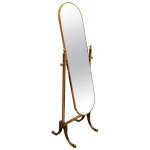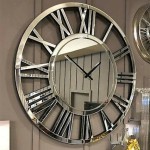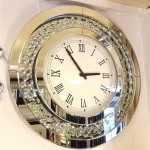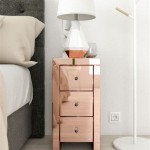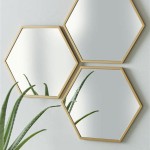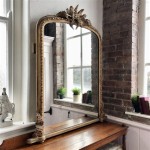What To Use To Hang Large, Heavy Mirrors
Hanging a large, heavy mirror can be a daunting task. Choosing the correct hanging hardware is crucial for safety and stability, preventing potential damage to both the mirror and the wall. This article outlines various options for hanging heavy mirrors, explaining the strengths and weaknesses of each method.
Understanding Weight Capacity: Before selecting any hanging method, accurately determine the mirror's weight. Use a bathroom scale or consult the manufacturer's specifications. Every hanging hardware option has a specified weight capacity, which must be exceeded by a significant margin for optimal safety. Aim for a weight capacity that is double the weight of the mirror.
D-Rings and Wire: D-rings are metal rings attached to the back of the mirror frame. They are used in conjunction with picture wire, which is looped through the D-rings and then hung on hooks or nails in the wall. This method is suitable for moderately heavy mirrors. Ensure the D-rings are securely attached to the frame, preferably into the frame's structural members, not just the backing. Heavy-duty picture wire, rated for the mirror's weight, should be used. This method offers flexibility in adjusting the mirror's position after hanging.
Heavy-Duty Picture Hangers: Several types of heavy-duty picture hangers are available, designed specifically for heavier objects. These often feature multiple nails or screws and interlocking metal components to distribute the weight across a larger wall area. These hangers are typically rated for specific weight ranges, so choosing one that well exceeds the mirror's weight is vital. Carefully follow the manufacturer’s instructions for installation.
French Cleats: French cleats offer a robust and secure hanging solution for large, heavy mirrors. A French cleat system consists of two interlocking pieces of wood or metal. One piece is attached to the wall, and the other to the back of the mirror. The angled design of the cleats creates a strong grip when the two pieces interlock. This method provides a flush mounting against the wall. Ensure the cleat is appropriately sized for the mirror's weight and dimensions. The wall cleat must be anchored into wall studs for maximum stability.
Mirror Mounting Clips: Mirror mounting clips, also known as J-clips or Z-clips, offer another secure hanging method. These clips grip the edges of the mirror and are attached to the wall. They are often used in conjunction with adhesive for added security. This method is particularly suitable for frameless mirrors. Select clips specifically designed for heavy mirrors and ensure the wall mounting points are strong enough to support the weight.
Toggle Bolts: For walls constructed of hollow materials like drywall, toggle bolts provide a strong anchoring point. A toggle bolt expands behind the wall, distributing the weight over a larger area. These are used in conjunction with other hanging hardware, such as D-rings or French cleats, to secure the mirror to the wall. Ensure the toggle bolts are appropriately sized for the weight of the mirror and the thickness of the wall.
Wall Anchors: Various wall anchors are available, providing alternative anchoring solutions for different wall types. These include plastic expansion anchors, threaded metal anchors, and self-drilling anchors. The choice of anchor depends on the wall material and the weight of the mirror. Always select anchors rated for the specific weight and wall type.
Adhesive: Specialized mirror adhesives can be used for lighter mirrors or as a supplementary method for added security when combined with other hanging hardware. However, relying solely on adhesive for heavy mirrors is not recommended. The adhesive must be compatible with both the mirror backing and the wall material. Always follow the manufacturer's instructions for application and curing time.
Professional Installation: For extremely large or heavy mirrors, professional installation is highly recommended. Professional installers possess the experience and specialized tools necessary to safely and securely hang these items. They can also assess the wall structure and determine the most appropriate hanging method.
Wall Considerations: Before attempting to hang a heavy mirror, assess the wall's structure. Locate wall studs using a stud finder. For optimal support, heavy mirrors should ideally be anchored directly into wall studs. If mounting to drywall without hitting a stud, use appropriate wall anchors, such as toggle bolts, rated for the weight of the mirror. Plaster walls may require specialized anchors.
Safety Precautions: When hanging a heavy mirror, prioritize safety. Use appropriate safety gear, such as gloves and eye protection. Enlist the help of another person for lifting and positioning the mirror. Double-check all measurements and ensure the hanging hardware is correctly installed before hanging the mirror. After hanging, periodically inspect the hanging hardware to ensure it remains secure.

How To Hang A Large Or Heavy Mirror

How To Hang A Heavy Mirror Or Picture True Value
How To Hang A 100 Pound Mirror On Drywall Quora

How To Hang A Heavy Mirror Securely Bob Vila

How To Hang A Heavy Mirror C R F T

How To Hang A Heavy Mirror C R F T Hanging Diy Home Improvement

A Better Way To Hang Heavy Mirror Hanging Pictures

How To Hang A Heavy Mirror Diy Family Handyman

How To Hang A Heavy Mirror

How To Hang A Heavy Mirror


